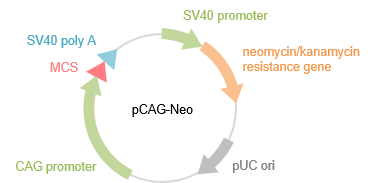Protein Expression Vectors
In protein expression, the most widely used method is to incorporate the gene of interest into a protein expression vector. Protein expression vectors contain sequences necessary for gene transcription and translation, such as promoters, terminators, and translation initiation signals. Fujifilm Wako offers plasmid vectors optimized for protein expression in mammalian cells.
Product Line-up
More Information
Characteristics of Protein Expression Vectors
In protein expression, the most widely used method is to incorporate the gene of interest into a protein expression vector. Protein expression vectors contain sequences necessary for gene transcription and translation, such as promoters, terminators, and translation initiation signals. In many cases, the SV40 promoter is also incorporated to express large amounts of the target protein in cells expressing the large T antigen, such as HEK293T cells or COS-7 cells. In addition, an antibiotic resistance gene is incorporated to select cells. Protein expression vectors with the target genes are introduced into mammalian cells and other host cells by transfection or other methods.

Figure 1 Example of a Protein Expression Vector (pCAG-Neo)
The gene encoding the target protein is incorporated into the multiple cloning site (MCS) located downstream of the CAG promoter. The SV40 promoter is used for the expression of the target protein at high levels in HEK293T or COS-7 cells. The neomycin/kanamycin resistance gene is used for the selection of cells in drug resistance screening.
Protein expression using protein expression vectors allows for artificial alterations of the gene sequence according to purposes. For example, a fusion to a fluorescent protein or a peptide that serves as an affinity tag is often incorporated at the end of the target protein to facilitate purification and detection. It is also possible to adjust the expression level of the target protein by using different promoters.
It should be noted that protein expression experiments are greatly influenced by the cell type and transfection method. Depending on the experimental conditions, the expression levels of the target protein could be low. In addition, gene expression by transfection of protein expression vectors is transient, because plasmid vectors cannot be replicated in mammalian cells. In some cells, the gene is integrated into the genome, resulting in stable transfectants, but the probability is very low (1/100 to 1/1,000,000), and drug resistance screening is required to select stable transfectants. In recent years, new technologies to promote the efficiency of gene expression have been developed, and these issues are being overcome.
For research use or further manufacturing use only. Not for use in diagnostic procedures.
Product content may differ from the actual image due to minor specification changes etc.
If the revision of product standards and packaging standards has been made, there is a case where the actual product specifications and images are different.



